
HOME
INTRO
SYMBOLS
ALMANAC
ECONOMY
GEOGRAPHY
STATE MAPS
PEOPLE
FORUM
NEWS
COOL SCHOOLS
STATE QUIZ
STATE LINKS
BOOK STORE
MARKETPLACE
GUESTBOOK
CONTACT US


You may double left-click on a word on this page to retrieve its definition. Tweet Follow
Maryland State Folk Dance
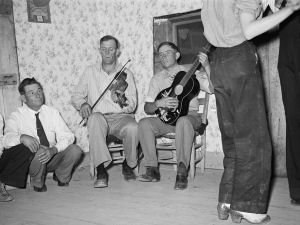
Traditional Square Dance Musicians
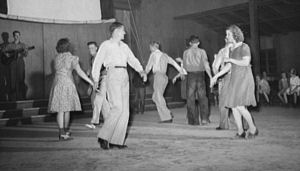
Saturday Night Square Dancing (1942)
Square dancers in states that have successfully lobbied their legislators to declare the square dance as the state's official American folk dance, or a similar title, have usually been well organized.
Frank and Helen Cavanaugh were chairmen of LEGACY International's American Folk Dance Committee and instrumental in organizing square dancers throughout the states to lobby for state designations to leverage future attempts to designate the square dance official at a national level. According to the Cavanaughs, in the August, 1994 issue of American Square Dance magazine, the lead in Maryland was assumed by Richard and Linda Peterson. Read more about the national campaign here.
Richard Peterson testified forcefully at legislative committee hearings in support of designating the square dance the official American folk dance of Maryland. In fact, Richard Peterson is credited with salvaging the legislation after it had received a unanimous "no" vote in the House Appropriations Committee.
It's not clear to us at this time when effort began but, in 1994, a bill to designate square dancing the official state folk dance of Maryland was introduced to the Maryland General Assembly by State Senator Leo E. Green representing Senate District 23, Prince Georges County.
On March 29, 1994, a hearing was held by the House Appropriations Committee where dancer Stan Fowler testified against the bill.
According to Julie Mangin's piece, "The State Folk Dance Conspiracy: Fabricating a National Folk Dance," Mr. Fowler contested enactment of the legislation based on the following points:
- If the purpose of a state symbol is to distinguish the state, it doesn't make sense to select a symbol that many other states have adopted.
- There is nothing unique about the dancing proposed in the legislation. One could visit any state and witness the same kind of dancing as was proposed to represent Maryland.
- The dancing proposed by the legislation was exclusionary. He quoted an article in the Washington Post from February 6, 1987, in which a historian for a local modern Western square dance association said, "We kind of look down our nose at square dancing over at Glen Echo. It's totally open to the public, and they don't meet our criteria for being a member of the Washington Area Square Dance Cooperative Association."
- It would be impossible to select any specific dance as representative of Maryland because of the cultural diversity of the state.
According to Julie Mangin, Mr. Fowler's testimony resulted in a unanimously negative vote in committee. It appeared that the legislation was stopped.
But, according to Ms. Mangin, Mr. Fowler's testimony was countered by a letter to Mr. Howard "Pete" Rawlings (Chairman of the House Appropriations Committee) from Richard Peterson of the Washington Area Square Dance Cooperative Association and chair of the Maryland American Folk Dance Committee which suggested economic benefit to Maryland should square dancing be approved as the official state folk dance.
"We had intended to bid for the national square dance convention again...this June. In 1984, we had the national in Baltimore and attracted over 25,000 square dancers. With the negative vote we received from the House Appropriations Committee, this makes our bid rather useless. The conventions have been going to other states that have passed the legislation."
(Mangin, "Julie's Tacky Treasures", 2003)
The committee reconsidered and approved the legislation on April 9, 1994. The bill was approved by the House of Delegates and the Senate and forwarded to Governor William Donald Schaeffer for his signature. On May 27, 1994, Gov. Schaeffer signed the legislation designating square dancing as the official state folk dance of Maryland.
Modern western square dance clubs across the country have collaborated to have the square dance declared the state folk dance in all fifty states. The primary purpose of this state level activity is to create leverage to designate the square dance as the national folk dance of the United States of America. They think big!
There is some controversy over their efforts. More information regarding pressure at the national level to designate the square dance the official American folk dance on a federal level can be found here and in "Additional Information" section below.
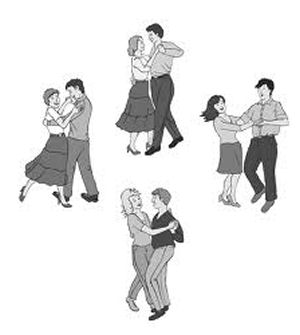
Maryland State Folk Dance: Square Dancing
The square dance is a popular type of folk dance in the United States. This dance for four couples, or groups of four couples, is performed in a compact framework of a square, each couple forming a side. Traditionally accompanied by a fiddle, accordion, banjo and guitar, the couples perform a variety of movements prompted by the patter or singing calls (instruction) of a "caller". Cooperative movement is the hallmark of well-executed square dancing.
Square dancing is to be distinguished from related dances called contra or longways dance where couples stand double file in a line and from round dances where couples stand in a circle. The origin of the square dance can be traced to English derivation and to the stately French cotillion performed in square formation that was popular at the court of Louis the fifteenth later replace by the quadrille (another square dance).
This, regarding the state's official folk dance from the Maryland State Archives:
In 1994, Square Dancing was designated the State Folk Dance (Chapter 707, Acts of 1994; Code General Provisions Article, sec. 7-315).
Square Dancing originally referred to any folk dance performed in a square formation, but now encompasses any folk dance tradition brought to these shores.
("Maryland Manual Online", 2015)
A brief description of the efforts to declare the square dance the national folk dance of the United States of America can be found here.
Maryland Law
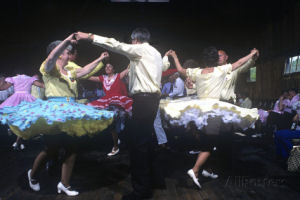
Maryland State Folk Dance: Square Dancing
Posters and Photographs
The following information was excerpted from the Maryland Code, State Government, Title 13, Subtitle 3, Section 13-314.
STATE GOVERNMENT
TITLE 13. EMBLEMS; COMMEMORATIVE DAYS; MANUAL
SUBTITLE 3. ADDITIONAL EMBLEMS; DESIGNATIONS
SECTION 13-314
§13-314. Folk Dance. Square dancing is the State folk dance.
[1994, ch. 707.]
Sources...
Cavanaugh, Frank, and Helen Cavanaugh. "Square Dance - American Folk Dance of the States." American Square Dance Aug. 1994: 59. Print.
Mangin, Julie. "The State Folk Dance Conspiracy: Fabricating a National Folk Dance." Julie's Tacky Treasures. 22 Apr. 2003. Web. 25 Feb. 2005.
"Maryland State Folk Dance - Square Dance." Maryland Manual Online. State of Maryland, 29 Sept. 2015. Web. 27 Feb. 2016.
Shearer, Benjamin F. and Barbara S. State Names, Seals, Flags and Symbols: A Historical Guide Third Edition, Revised and Expanded. Westport, Conn: Greenwood Press, 3 Sub edition, 2001.
Additional Information
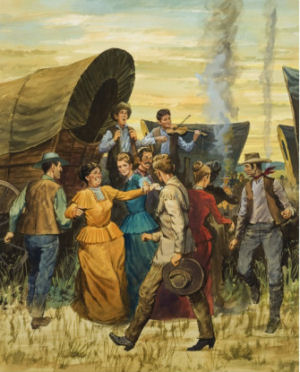
Maryland State Folk Dance: Square Dancing
Posters and Photographs
Square Dancing 101: Square dancing basic including positions, formations, moves, and a glossary.
Video Square Dance Lessons Online: Video Square Dance Lessons Online and on DVD from Cyberpoint Marketing, LLC.
A Brief History of Square and Round Dancing: by Herb Egender.
Square Dancing: The Historical Geography of an American Folk Custom: by Richard M. MacKinnon, Allan Hancock College, Santa Maria, California.
Square Dance History Project: Website devoted to the documenting the history of square dancing with historical documents and an emphasis on imagery as much as possible.
History and Heritage of Modern American Square Dancing: A summary of the essays by Dorothy Shaw, Bob Osgood and Kenny Reese.
The State Folk Dance Conspiracy: Fabricating a National Folk Dance: by Judy Mangin - Originally published in the Old-Time Herald, v.4(7) p.9-12, Spring 1995.
National Folk Dance Effort Moves Forward: We're On Our Way Now, So Let's Make a Lot of Noise!: United Square Dancers of America National Folk Dance Committee.
The Square Dance Legislation Collection: American Folklife Center 1984/024, Compiled by Michelle Forner, Library of Congress, Washington DC, December 1994
Official website: Mason Dixon Square Dancers Association, Inc.
Official website: Washington Area Square Dancers Cooperative Association, Inc. (WASCA).
State dances: Complete list of official state dances from NETSTATE.COM
More symbols & emblems: Complete list of official Maryland state symbols from NETSTATE.COM.
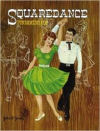
Square Dance Fundamentals
John W. Jones
Square Dance Fundamentals, John W. Jones. 208 pages. Publisher: BookSurge Publishing (February 5, 2007)
While there have been countless fun books written on square dancing, Squaredance Fundamentals was the first to cut to the chase. There is no interesting history of square dancing, there are no entertaining anecdotes, just the nuts and bolts of how to square dance. Revolutionary illustrations show the dancer’s point of view, not just the spectators’ viewpoint. Dancers can, without turning on their heads, glean from the detailed illustrations exactly what they need to be doing with their hands, feet, etc. Each dancer can effortlessly grasp the material and easily retain it. Renowned master caller/teacher, Marshall Flippo, assiduously assisted the author in establishing the very first guidelines for standardized “Basic Maneuvers” which would enable square dancers to dance gracefully with any group, anywhere.
No one shows you better how to execute the maneuvers than John W. Jones with his super simplified instructions and state-of-the-art illustrations in Squaredance Fundamentals - the gold standard for over 37 years.
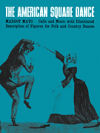
The American
Square Dance
Margot Mayo
The American Square Dance, by Margot Mayo. 116 pages. Publisher:Music Sales American (September 1, 2006)
You can have fun square dancing and you'll learn how to dance the figures and even learn how to call a square dance with Margot Mayo's classic manual, The American Square Dance. Here is the basic book for square dancers containing all of the essentials for many hours of enjoyment. An illustrated glossary of square dance terms shows all of the basic square dance figures – promenade, allemande left, do-si-do, etc. Complete instructions, calls and illustrated figures for 13 of the most popular American square dances appear, plus the music all ready for your pianist and fiddlers to play.
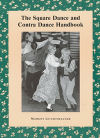
The Square Dance and
Contra Dance Handbook
Margot Gunzenhauser
The Square Dance and Contra Dance Handbook: Calls, Dance Movements, Music, Glossary, Bibliography, Discography, and Directories, by Margot Gunzenhauser. 320 pages. Publisher: McFarland & Company, Inc., Publishers; annotated edition (July 28, 2010)
This comprehensive guide to traditional style square and contra dancing, sometimes referred to as "country dancing," covers both music and style and gives background information on various dance types and calling techniques. Ninety dances, presented in chapters according to type (mixers, progressive circles, contra, Southern mountain style, squares and others), in a wide variety of formations are described with drawings and diagrams for many of the movements. A glossary of terms, a directory of addresses (organizations; vendors of books, recordings and audio equipment; and dance camps), and an annotated discography and bibliography are also provided.
A glossary of terms, a directory of addresses (organizations; vendors of books, recordings and audio equipment; and dance camps), and an annotated discography and bibliography are also provided.
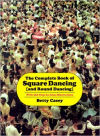
The Complete Book
of Square Dancing
(and Round Dancing)
Betty Casey
The Complete Book of Square Dancing (and Round Dancing), by Betty Casey. 208 pages. Publisher: University of North Texas Press (June 1, 2000)
This book includes: 50 basic movements, 35 advanced movements, variations, dances that are a part of the American heritage, Contra and Round Dances, polkas and reels, and calls, past and present.
“Square dancing is friendship set to music,” says author Betty Casey. Just take four couples, old or young, put ’em on a good floor, turn on the music, and you’re all set. Whether you’ve done it before or you’re just starting out, this book tells you everything you need to know—85 basic movements used all over the world, the spirited calls unique to square dancing, the costumes and equipment that are best, and music (from “Red River Valley” to “Mack the Knife”) that will set your feet in motion.
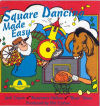
Square Dancing
Made Easy
Square Dancing Made Easy, Grade level: K-6. Audio CD (September 1, 1995), Number of Discs: 1, Label: Educational Activities, Inc.
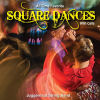
All Time Favorite
Square Dances
All Time Favorite Square Dances with Calls, Audio CD (September 8, 2009), Number of Discs: 1, Label: KADO, Run Time: 60 minutes.
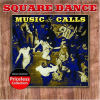
Square Dance Music
& Calls
Square Dance Music & Calls, Audio CD (November 21, 2006), Number of Discs: 1, Label: Collectables Records.
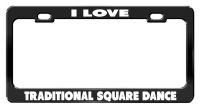
Black Metal
License Plate Frame
I LOVE TRADITIONAL SQUARE DANCE Black Metal Car Accessories License Plate Frame, This high quality license plate frame is made of metal, and it's the best quality item of its kind in the market. The lettering and art work are done by waterproof vinyl on the license plate frame and it will last for many years without any damage. It will not get brittle or cracked. It fits on all USA and Canada vehicles. It measures 12.5" X 6.5" and is durable to last under all weather conditions.
- Heavy Duty High Quality Metal License Plate Frame.
- Perfect Gift idea And Easy Installation.
- Rust, Corrode And Fade Free For Many Years.
- Fits all US and Canada License Plates.
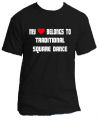
Traditional Square
Dance T-Shirt
MY HEART BELONGS TO TRADITIONAL SQUARE DANCE, This is a high quality pre-shrunk t-shirt that will not shrink or fade. It's comfortable, casual and loose fitting and will quickly become one of your favorites. It wears and looks well on anyone. It is cured with a heat treatment process to ensure lasting durability.
Brand New High quality preshrunk tee-shirt that will not shrink or fade. Double-needle stitched hemmed sleeves and bottom. Highest quality printing materials. 50% Cotton, 50% Polyester preshrunk blend. Soft, comfortable and weighs 6 oz.
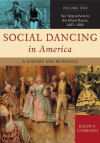
Social Dancing in America: A History and Reference (Volume One), by Ralph G. Giordano. 380 pages. Publisher: Greenwood (November 30, 2006)
Social Dancing in America examines the role of social dancing in daily life from the first settlements in 1607 through the birth of the nation in 1776 and into the beginning of the 21st century. This two-volume set provides a history of American social dances including the Virginia Reel, Square Dancing, the Lindy Hop, Rock 'n' Roll, the Twist, Disco, Breakdancing, and Hip-Hop. Social Dancing in America places social dancing in a historical, social, cultural, and political context.
Volume 1 explores the integral role that social dancing played in the lives of Americans from the first settlements in 1607 through the 19th century, often in the most unlikely of ways. For example, readers may be surprised to learn that George Washington was a well-known aficionado of social dancing, and that he incorporated the etiquette and manners of dances such as the Minuet as a means of diplomacy to secure European allies during the Revolutionary War. After his death, Americans continued to celebrate his birthday with a grand ball that included dancing.
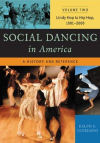
Social Dancing in America: A History and Reference (Volume Two), by Ralph G. Giordano. 428 pages. Publisher: Greenwood (November 30, 2006)
Volume 2 places social dance in a 20th-Century context, illustrating how social dancing itself paralled the social, economic, and cultural traditions of each era. For example, segregation and the Jim Crow mentality was cemented in place all over the United States, and for much of the century, dancing and dance halls were strictly segregated. Segregation forced a mass migration north, and with it came the transformation of Delta Blues music into an American original—Jazz. Jazz gave birth to the Charleston, and later evolved into Swing, which created the Lindy Hop. Later, with the advent of television, programming such as American Bandstand, Soul Train, Dance Fever, and MTV greatly influenced dance styles and modern trends such as Rock 'n' Roll, Freestyle, Disco, Breakdancing, and Hip-Hop.

